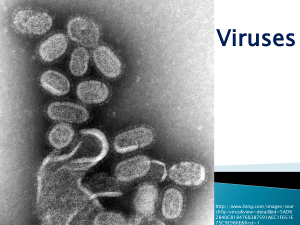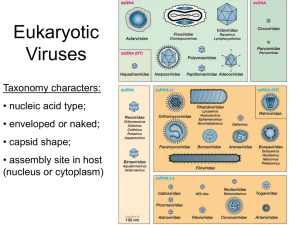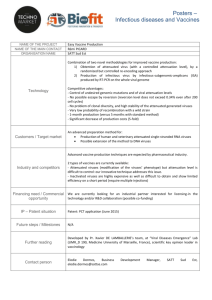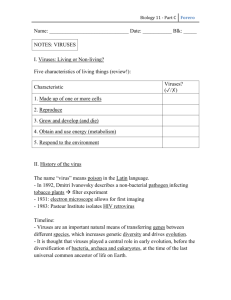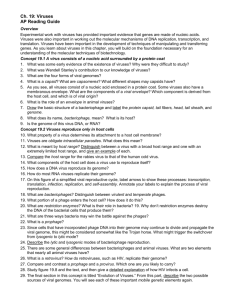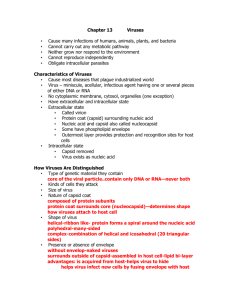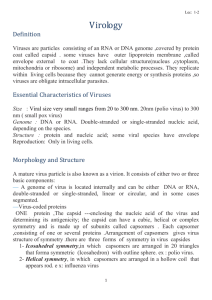Viruses
advertisement
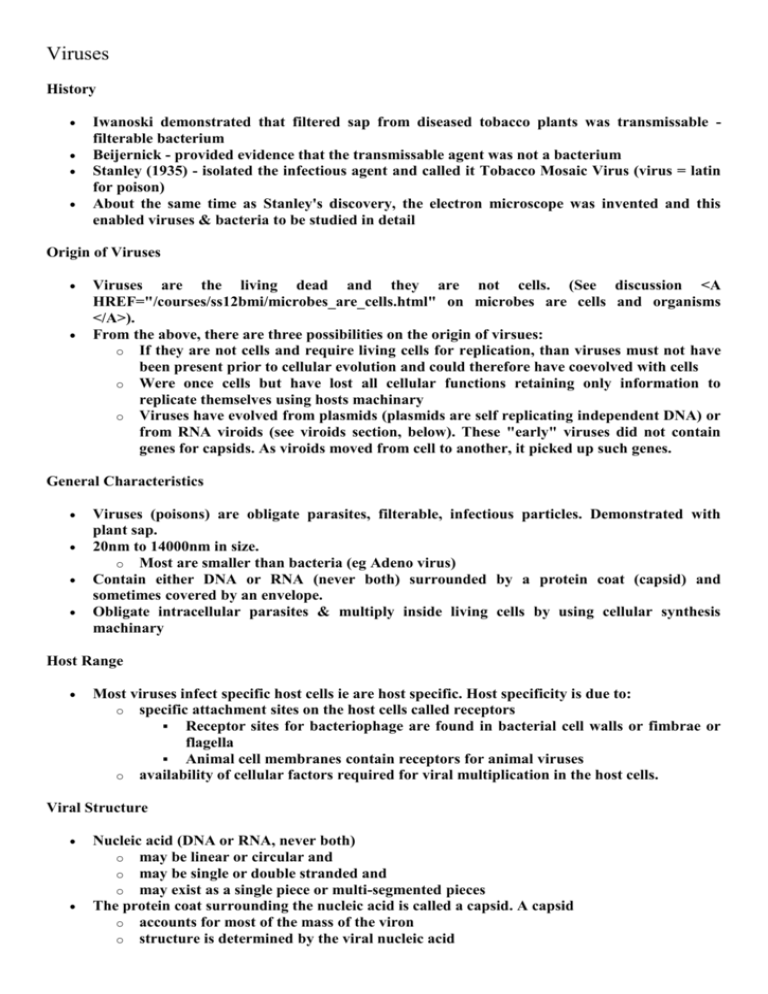
Viruses History Iwanoski demonstrated that filtered sap from diseased tobacco plants was transmissable filterable bacterium Beijernick - provided evidence that the transmissable agent was not a bacterium Stanley (1935) - isolated the infectious agent and called it Tobacco Mosaic Virus (virus = latin for poison) About the same time as Stanley's discovery, the electron microscope was invented and this enabled viruses & bacteria to be studied in detail Origin of Viruses Viruses are the living dead and they are not cells. (See discussion <A HREF="/courses/ss12bmi/microbes_are_cells.html" on microbes are cells and organisms </A>). From the above, there are three possibilities on the origin of virsues: o If they are not cells and require living cells for replication, than viruses must not have been present prior to cellular evolution and could therefore have coevolved with cells o Were once cells but have lost all cellular functions retaining only information to replicate themselves using hosts machinary o Viruses have evolved from plasmids (plasmids are self replicating independent DNA) or from RNA viroids (see viroids section, below). These "early" viruses did not contain genes for capsids. As viroids moved from cell to another, it picked up such genes. General Characteristics Viruses (poisons) are obligate parasites, filterable, infectious particles. Demonstrated with plant sap. 20nm to 14000nm in size. o Most are smaller than bacteria (eg Adeno virus) Contain either DNA or RNA (never both) surrounded by a protein coat (capsid) and sometimes covered by an envelope. Obligate intracellular parasites & multiply inside living cells by using cellular synthesis machinary Host Range Most viruses infect specific host cells ie are host specific. Host specificity is due to: o specific attachment sites on the host cells called receptors Receptor sites for bacteriophage are found in bacterial cell walls or fimbrae or flagella Animal cell membranes contain receptors for animal viruses o availability of cellular factors required for viral multiplication in the host cells. Viral Structure Nucleic acid (DNA or RNA, never both) o may be linear or circular and o may be single or double stranded and o may exist as a single piece or multi-segmented pieces The protein coat surrounding the nucleic acid is called a capsid. A capsid o accounts for most of the mass of the viron o structure is determined by the viral nucleic acid o is made up of protein subunits called capsomers. Capsomers maybe composed of single type of protein several types of proteins arrangement of capsomers is characteristic of a particular type of virus Capsomers determine antigenicity of the viron Some capsids are surrounded by an envelope. The envelope: o contains lipids, proteins & carbohydrates o is derived from host cell membranes (can evade host defence mechanism) and / or may contain some proteins synthesised from viron genes and / or may contain some material derived from normal host cell components o may be covered by spikes. Spikes: are made up of carbohydrate & protein complexes & project out into space from the surfaces of the envelope used for attachment to host cells Influenza viruses bind to RBC to form hemagglutination (diagnostic) Four morphological types of viruses based on the structure of the capsid and envelope geometry. o Helical viruses -- nucleic acid is surrounded by capsids which form long hollow rods (TMV, bacteriophage M13). o Polyhedral virsues -- capsids forming multiple (many) sides. Icosahedron is a regular polyhedron with 20 triangular faces & 12 corners (Adeno virus). o Enveloped -- Pleomorphic to spherical shapes due to presence of an envelope. Enveloped helical virus - Influenza virus Enveloped poyhedral virus- Herpes Simplex o Complex-- Complex stuctures in case of Lamda, T-odd & T-even polyhedral capsid + nucleic acid forms the head helical tail (sheath, tail fibres + pin, and baseplate) The life cycle of viruses may be divided into the following stages: 1. Attachment Attachment is a specific binding between viral surface proteins and their receptors on the host cellular surface. This specificity determines the host range of a virus. 2. Penetration Following attachment, viruses may enter the host cell through receptor mediated endocytosis or other mechanisms 3. Uncoating Uncoating is a process that viral capsid is degraded by viral enzymes or host enzymes. 4. Replication Replication involves assembly of viral proteins and genetic materials produced in the host cell. 5.Release Viruses may escape from the host cell by causing cell rupture (lysis). Enveloped viruses typically "bud" from the host cell. During the budding process, a virus acquires the phospholipid envelope containing the embedded viral glycoproteins. Lysogenic cycle Lysogenic cycle, compared to lytic cycle Lysogeny, or the lysogenic cycle, is one of two methods of viral reproduction (the lytic cycle is the other). Lysogeny in prokaryotes is characterized by integration of the bacteriophage nucleic acid into the host bacterium's genome. The newly integrated genetic material, called a prophage can be transmitted to daughter cells at each subsequent cell division, and a later event (such as UV radiation) can release it, causing proliferation of new phages via the lytic cycle. Lysogenic cycles can also occur in eukaryotes, although the method of incorporation of DNA is not fully understood.
